- Mechanisms of Tuina
- Commonly Used Acupoints
- The Basic Technical Methods
- Tuifa (推法, Pushing Manipulation)
- Nafa (拿法, Grasping Manipulation)
- Anfa (按法, Pressing Manipulation)
- Mofa (摩法, Circular Rubbing Manipulation)
- Roufa (揉法, Kneading Manipulation)
- Zhenfa (振法, Vibrating Manipulation)
- Dianfa (点法, Point-Pressing Manipulation)
- Jifa (击法, Percussing Manipulation)
- Mofa (抹法, Wiping Manipulation)
- Qiafa (掐法, Nipping Manipulation)
- Doufa (抖法, Shaking Manipulation)
- Yaofa (摇法, Rotating Manipulation)
- The Tuina Procedure
- Brief Introduction to Nanjing Tuina Massage 24
- General Treatment Procedure of Nanjing Tuina Massage 24
- Detailed Manipulation and Function
- Contraindications for Nanjing Tuina Massage 24
- Tuina Self-Massage
Mechanisms of Tuina
Balancing Yin and Yang
Tuina massage can effectively balance the Yin and Yang energies of the body. When we apply massage to different acupoints or meridians, Yin and Yang may be increased or decreased. Therefore, we select different acupoints to adjust and return Yin and Yang to a state of equilibrium. For example, if the body is suffering from Yang deficiency we may apply Tuina to GV 4 Mingmen, or “Vital Gate,” the Life Gate Fire, which stores and releases Yang-Qi. Similarly, if the body has Yin deficiency, we may apply Tuina to K I3 Taixi, Greater Stream, to release additional Yin to the system.
Regulating Zang and Fu Organs
Generally speaking, Zang organs can easily become deficient and Fu organs can easily suffer from excess. To overcome deficiency in a Zang organ, we apply tonifying Tuina to the pertaining Zang meridian or related acupoints. For example, applying tonifying Tuina to the spleen Meridian or appropriate acupoints will nourish the body to resolve spleen deficiency. On the other hand, we can resolve an excess in the large intestine by applying reducing Tuina to the large intestine meridian or acupoints.
Clearing Meridians
Some diseases are caused by Qi stagnation or blood stasis in the meridians. If we apply Tuina to the affected meridian or pertaining acupoints, the stagnation of Qi and Blood can be eliminated. For example, Qi stagnation can be relieved by applying Tuina to the acupoint CV 17 Tanzhong (also called Danzhong) or LR 3 Taichong Similarly, blood stasis can be treated through applying Tuina to SP 10 Xuehai or BL 17 Geshu.
Repairing Tissues and Organs
Some diseases are caused by dislocation of or damage to body tissues or organs. When we apply Tuina to the corresponding meridians and acupoints, the dislocation or damage may be treated. For example, it is possible to correct the dislocation of a spinal disk by applying Tuina to the local area and returning the disk to its proper position in the vertebral column. Similarly, when there is muscle or organ damage due to a car accident, local application of Tuina speeds healing.
Commonly Used Acupoints
KI 1, Yongquan — Gushing Spring, Tianyi  Spring
Spring
Function: This bottommost acupoint, also called the Jian Palace  , is the main exit route of turbid energy from the body to the universe. It is a special Jing Well point for critical conditions. It is very effective for the resolution of excessive stagnation of energy, which may induce pain, distension, irritability, insomnia, mental disorder, etc.
, is the main exit route of turbid energy from the body to the universe. It is a special Jing Well point for critical conditions. It is very effective for the resolution of excessive stagnation of energy, which may induce pain, distension, irritability, insomnia, mental disorder, etc.
KI 3, Taixi — Greater Stream (Also Known as Great Ravine)
Function: KI 3 is also the Yuan Source point  of the Kidney Meridian, as well as the representative point for tonifying the kidney. It is effective for treating such kidney deficiency symptoms as low back and knee joint pain, infertility, mal-development of either the physical body or wisdom, weak bones, tinnitus, and deafness.
of the Kidney Meridian, as well as the representative point for tonifying the kidney. It is effective for treating such kidney deficiency symptoms as low back and knee joint pain, infertility, mal-development of either the physical body or wisdom, weak bones, tinnitus, and deafness.
BL 40, Weizhong — Bend Middle (Also Known as Supporting Middle)
Function: As one of the four Command Points for front–back vertical circulation of Qi, BL 40 is in charge of the ascent of energy from the lower back to the upper back. It is effective for most disorders of the lower limbs, the back and posterior aspect of the trunk, including knee joint pain, lower back pain, etc.
GV 1, Changqiang — Long and Strong
Function: It is the first gate of the Du Meridian, and is named Wood Gate  . Here energy enters the abdominal cavity. This point is effective for most disorders of the abdomen, including abdominal pain, and abnormal bowel movements or urination, etc.
. Here energy enters the abdominal cavity. This point is effective for most disorders of the abdomen, including abdominal pain, and abnormal bowel movements or urination, etc.
GV 4, Mingmen — Vital Gate (Also Known as Gate of Life)
Function: It is the Gate of Life fire energy, called Rou Palace  . It can be considered the control button for Primary or Genuine Yang Qi
. It can be considered the control button for Primary or Genuine Yang Qi  . Most Cold diseases or Yang deficiency diseases, including Kidney-Yang deficiency, internal Cold syndromes, cold body and limbs, and so on, can be relieved by the manipulation of this point.
. Most Cold diseases or Yang deficiency diseases, including Kidney-Yang deficiency, internal Cold syndromes, cold body and limbs, and so on, can be relieved by the manipulation of this point.
GV 9, Zhiyang — Supreme Yang
Function: This point is the second gate of the Du Meridian, and is called Rock Gate  . Since it is the area through which energy enters the chest cavity, it is effective for most disorders of the chest, including chest pain, palpitations, or difficult breathing.
. Since it is the area through which energy enters the chest cavity, it is effective for most disorders of the chest, including chest pain, palpitations, or difficult breathing.
GV 14, Dazhui — Big Vertebra (Also Known as Great Hammer)
Function: Dazhui is the meeting point of the Yang meridians  and is the predominant acupoint for the body’s Yang Qi, and the neck and upper limbs. As such, it can successfully treat most Yang Qi disorders and neck and upper limb disorders. When external pathogenic factors invade the body, or one experiences pain, discomfort or limited movement in the neck, shoulders (e.g. “frozen shoulder”), or upper limbs, manipulation of this point can bring relief.
and is the predominant acupoint for the body’s Yang Qi, and the neck and upper limbs. As such, it can successfully treat most Yang Qi disorders and neck and upper limb disorders. When external pathogenic factors invade the body, or one experiences pain, discomfort or limited movement in the neck, shoulders (e.g. “frozen shoulder”), or upper limbs, manipulation of this point can bring relief.
GV 16, Fengfu — Wind Palace
Function: The third gate or Iron Gate  of the Du Meridian is also called Yi Palace
of the Du Meridian is also called Yi Palace  . Since it is in the area where pathogenic Wind may easily invade the body, GV 16 is valuable in treating Wind diseases, including headache, neck rigidity, dizziness and vertigo, and so on.
. Since it is in the area where pathogenic Wind may easily invade the body, GV 16 is valuable in treating Wind diseases, including headache, neck rigidity, dizziness and vertigo, and so on.
GB 20, Fengchi — Wind Pool (Also Known as Wind Gathering)
Function: The translation of Fengchi is Wind Pool  , revealing its importance as the major entrance through which external Wind pathogenic factor invades the body. This key Wind acupoint is indispensable for resolving external Wind diseases such as Wind-Cold or Wind-Heat syndromes.
, revealing its importance as the major entrance through which external Wind pathogenic factor invades the body. This key Wind acupoint is indispensable for resolving external Wind diseases such as Wind-Cold or Wind-Heat syndromes.
GV 20, Baihui — Hundred Convergences
Function: The uppermost acupoint of the body, located at the crown of the head, is also called Ying Palace  . It acts as the entrance for universal Qi into the body. This powerful point can nourish and support the person suffering from deficiency-type diseases marked by insufficient holding and raising energy, such as organ prolapse, diarrhea, frequent urination, or miscarriage.
. It acts as the entrance for universal Qi into the body. This powerful point can nourish and support the person suffering from deficiency-type diseases marked by insufficient holding and raising energy, such as organ prolapse, diarrhea, frequent urination, or miscarriage.
LU 7, Lieque — Broken Sequence, Thunder Conscious 
Function: LU 7 is one of the four Command Points for the body’s front–back vertical energy circulation. It has the function of connecting the top part and the bottom part of the body. Its specific function allows the free ascent of energy from the shoulders to the neck and head. Most disorders of the shoulders, neck, and back of the head can be remedied by the correct manipulation of this point.
PC 8, Laogong — Toil Palace (Also Known as Labor Palace)
Function: This acupoint processes and manages the energy of the body and is also called Qin Palace  . It is an effective point for mental/emotional/spiritual issues such as reduced motivation, apathy, sadness, depression, and fluctuating emotions.
. It is an effective point for mental/emotional/spiritual issues such as reduced motivation, apathy, sadness, depression, and fluctuating emotions.
LI 4, Hegu — Union Valley (Also Known as Joining Valley)
Function: Another of the four Command Points for the body’s front–back vertical energy circulation, LI 4 is also the upper component of the Four Gates. It is in charge of the descent of energy from the face to the throat and chest, as well as promoting the release of turbid energy and the circulation of stagnated energy in the head, trunk, and upper limbs. Most disorders of the face, throat, and chest, including facial paralysis or toothache, can be treated with the manipulation of this point.
Hand Jing Well Points: LU 11, Shaoshang — Lesser Shang (Lesser Metal); LI 1, Shangyang — Metal Yang; PC 9, Zhongchong — Middle Surging; SJ 1, Guanchong — Passage Surging; HT 9, Shaochong — Lesser Surging; SI 1, Shaoze — Lesser Marsh
Function: These points act as exits for turbid energy of the body through the hand meridians. Thus, they can release any turbid energy in the corresponding meridian. Pathogenic factors, including Heat, Toxins, and Wind, in the meridians and their related organ systems affecting the head, trunk, and upper limbs can be expelled through these points.
ST 36, Zusanli — Leg Three Miles, Three Part Manager
Function: This famous and extremely useful point is one of the four Command Points of the body’s front–back vertical energy circulation. In addition, it is one of the two longevity points. Since it is in charge of the descent of energy from the upper abdomen to the middle and lower abdomen, it is effective for many abdominal disorders, including epigastric pain, abdominal distension, or poor appetite.
SP 6, Sanyinjiao — Three-Yin Intersection
Function: As the translated name implies, this point is the location where all the three foot Yin meridians meet. It is the comprehensive tonifying acupoint for all abdominal organs. Its strong tonifying property relieves deficiency syndromes of the abdominal organs (Spleen, Liver, and Kidney).
LR 3, Taichong — Greater Surging (Also Known as Bigger Rushing)
Function: LR 3 is the lower component of the Four Gates. In a similar manner to LI 4, this point is in charge of releasing turbid energy and circulating stagnated energy, but the pertinent locations are the head, trunk, and lower limbs. It is the most powerful acupoint for relieving all kinds of stagnation in the body, especially as seen in such disorders as hypochondriac pain or stress due to Liver-Qi stagnation.
Foot Jing-Well Points: KI 1, Yongquan — Gushing Spring; SP 1, Yinbai — Hidden White; LR 1, Dadun — Great Thickness; ST 45, Lidui — Strict Exchange; GB 44, Zuqiaoyin — Foot Yin’s Orifice; BL 67, Zhiyin — Reaching Yin
Function: Just as the Hand Jing-Well points act as exits for turbid energy from the hand meridians, these points act as exits for turbid energy from their corresponding foot meridians. Pathogenic factors of the excess type, such as Heat, Toxins, or Wind, can be expelled from the meridians and related organ systems in the head, trunk and lower limbs.
EX-HN 5, Taiyang — Sun (Also Known as Great Yang)
Function: This is the most popular extraordinary acupoint on the head. As the general managing acupoint of the head, especially the lateral aspects, it is effective for local disorders, including facial paralysis, migraine headache, or cheek pain.
GV 26, Shuigou — Water Ditch (Also Known as Renzhong — Human Center)
Function: This point acts as a bridge connecting the Du and Ren Meridians, and relates to consciousness. Stimulating GV 26 can cause a person to regain consciousness. It is well known as a first aid point but is also effective for many mental or neurological disorders, such as coma, dementia, and anxiety.
CV 8, Shenque — Spirit Tower
Function: Located at the center of the umbilicus, CV 8 is the link between mother and child during pregnancy. Equally important, it is the portal through which the energy of the body’s exterior enters the “internal energy bank,” called He Palace  . Of all the points on the Ren Meridian, it is the most powerful for treating diseases of energy deficiency, such as dull abdominal pain or weakness, chronic illness, exhaustion. Note that this point is very effective with Tuina, but is not suitable for acupuncture needling.
. Of all the points on the Ren Meridian, it is the most powerful for treating diseases of energy deficiency, such as dull abdominal pain or weakness, chronic illness, exhaustion. Note that this point is very effective with Tuina, but is not suitable for acupuncture needling.
CV 6, Qihai — Sea of Qi
Function: It is the energy source and also one of the two longevity acupoints. Thus, it is the most powerful acupoint for tonifying Qi and is effective for energy deficiency disorders, including lassitude, fatigue, reduced body function, and so on.
LI 20, Yingxiang — Welcome Fragrance
Function: Yingxiang is the last acupoint of the Large Intestine Meridian and is the most sensitive acupoint on the face to the invasion of external Wind and Cold pathogenic factors. When one is applying the reducing method to this point, it very powerfully expels invading Wind and Cold from the body. This point is located on either side of the ala nasi and thus is useful for disorders of the nasal passages, such as rhinorrhea, nasal obstruction, or epistaxis.
CV 8, Zhongwan — Middle Stomach Cavity (Also Known as Middle of the Epigastrium)
Function: As the Front-Mu point of the Stomach, it is the most important and powerful acupoint for treating stomach-related disorders, including stomach pain or distension, heartburn, or stomach prolapse.
The Basic Technical Methods
Tuina manipulation techniques are the direct applications or manifestations of Tuina therapy. There are many kinds of operating skills and different styles of movements in Tuina, which include butting with the head and tramping under the foot, as well as continuous manipulations conducted with the finger, palm, wrist, and elbow. They are directly applied to the body surface to stimulate the body by means of exerting force to treat or prevent diseases. Since most of the manipulations are done with the hands, they are generally called manual manipulations or hand manipulations. The manipulation force may come from not only the fingers, palms, and wrists but also the elbows, shoulders, and waist.
Tuina manipulations should be persistent, forceful, even, and gentle. Persistence means that manipulations should be continued for a considerable period of time. Forcefulness means that manipulations should be performed with adequate force. Evenness means that manipulations should be rhythmical, with appropriate speed and steady force. Gentleness refers to light but not superficial, heavy, and smooth operations with a natural shift of movements, which should by no means be performed roughly and rigidly. The above four qualities are closely related to one another. To skillfully grasp various manipulations, long and persistent practice is necessary. In practice, the exercise should be done orderly and step by step, following a process from being inexperienced to skillfully developing perfection and proficiency.
In order to achieve a better curative action in clinical practice, Tuina manipulation techniques should follow TCM principles of differentiating syndromes to decide treatment strategies, which refers to applying different kinds of manipulations to different syndromes. Clients may be divided into senior and junior age groups. Client constitutions may be divided into weak and strong, and syndromes may be divided into deficient and excessive. The involved area can be small or big and the local area could be with more or less muscles. So the selection of manipulation techniques and application of force should be applied based on the above different conditions. Any excess or deficiency in manipulation will affect preventive and curative results or even cause some side effects.
Chinese Tuina massage has a long history. Its manipulation techniques are as many as several hundreds in number. There are some multiple manipulations combined with two individual manipulations, such as a combination of pressing and rubbing, palm-twisting and kneading, pinching and grasping.
Tuifa (推法, Pushing Manipulation)
Pushing manipulation consists of finger pushing, palm pushing, and elbow pushing. It is performed by placing the finger, palm, or elbow on a particular area of the client’s body to make one-way, rectilinear movements. Pushing with the finger is called finger pushing manipulation; pushing with the palm is called palm pushing manipulation, and pushing with the elbow is called elbow pushing manipulation.
During pushing manipulation, the finger, palm, and elbow should be kept touching the client’s body surface; pushing should be gentle, slow, and even.
It may be applied to all parts of the client’s body for increasing muscular excitement, promoting blood circulation, relaxing tendons, or activating meridians (see Fig. 18.1).
Nafa (拿法, Grasping Manipulation)
Grasping manipulation is performed by using the pad of the thumb and the index and middle fingers or the other four fingers to lift and pinch flesh or muscular parts of the client’s body, then holding the client’s body tissue or acupoints with the thumb on one side and fingers on the other side.
During grasping manipulation, the movement is performed rhythmically and with a shearing or opposing force. The applied force ranges from light to moderately heavy, and sudden exertion should be avoided. The overall manipulation should be even, slow, and coherent.
It may be applied to the neck, nape, shoulder, and limbs in combination with other manipulations for alleviating pain, relaxing tendons, or normalizing meridians.
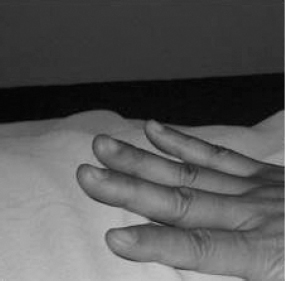
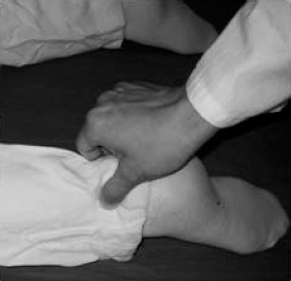
Anfa (按法, Pressing Manipulation)
Pressing manipulation is the general term for finger pressing and palm pressing manipulation.
Pressing the body surface with the tip of the thumb or the pad of a finger is called finger pressing manipulation. Pressing the body surface with one or two palms or overlapping palms is known as palm pressing manipulation. In any type of Anfa, the pressure is exerted straight down.
During the pressing manipulating, the practitioner’s body surface should be kept touching the client’s body surface without moving. The pressing should be gentle, and gradually increase the power. Rigid or sudden pressing should be avoided.
Finger pressing may be applied to all points of the client’s body, and palm pressing may be applied to the client’s back and abdomen. These manipulations are used for relaxing muscles, eliminating obstructions, activating blood circulation, or alleviating pain .
Mofa (摩法, Circular Rubbing Manipulation)
This method is divided into palm rubbing and finger rubbing.
Palm rubbing is performed by placing the palmar surface of the hand on a flat area of the body, and moving the palm, wrist, and forearm together in a rhythmic and circular pattern, with the wrist joint as the center or pivot.
Finger rubbing is performed by fixing the index, middle, and ring fingers on the involved part, and inscribing small circles with the wrist joint as the central axis.
This manipulation produces light, mild to moderate stimulation, and is commonly used on the chest, abdomen, and hypochondriac regions for harmonizing the digestive system, circulating Qi, or eliminating stasis and food retention.
Roufa (揉法, Kneading Manipulation)
Kneading manipulation includes palm and finger kneading.
Palm kneading manipulation is performed by placing the major thenar or the palmar base on the client’s body part or acupoint, relaxing the wrist, swaying the forearm initiatively and bringing the wrist to sway slowly and softly with the elbow as a pivot.
Finger kneading manipulation is performed by placing the whorled surfaces of the fingers on the client’s body surface part or acupoint, relaxing the wrist, having the forearm make an initiative swaying movement and bringing the wrist, palm, and finger to sway slowly and softly with the elbow as a pivot.
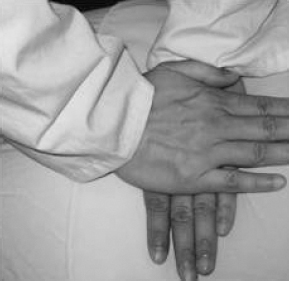
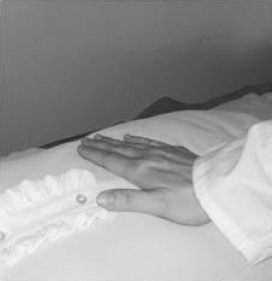
This manipulation should be done gently, with less pressure, and its movements should be coordinated and rhythmic at a frequency of 120–160 times per minute.
It may be applied to all points in the client’s body for soothing chest Qi circulation, improving digestion, activating blood circulation, eliminating blood stasis, subduing swelling, or relieving pain .
Zhenfa (振法, Vibrating Manipulation)
The vibrating manipulation is divided into palm vibrating and finger vibrating manipulation.
Vibrating manipulation involves fixing the fingers or palm on one specific part of the client’s body surface and exerting intense force to produce a quivering or pulsating motion through using the tendons of the forearm and hand or fingers.
During this manipulation, the mind is focused on the fingertips or palm, the vibrating frequency should be great, and the pressing should be slightly forceful.
It may be applied to all parts and points of the client’s body for eliminating stasis, alleviating swelling, normalizing the digestive system, or circulating Qi (see Fig. 18.6).
Dianfa (点法, Point-Pressing Manipulation)
Point-pressing manipulation is performed by bending the middle finger or both the index and the middle finger, exerting force on the involved points with the tip of the proximal interphalangeal joint, gradually increasing the force, and pressing inward. The pressing is kept up for a proper time. This technique may be applied to most of the points all over the client’s body for dispelling Wind and Cold, ascending adverse Qi, subduing vomiting, relaxing the body, or calming the Mind and Shen (see Fig. 18.7).
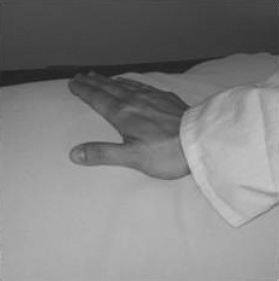
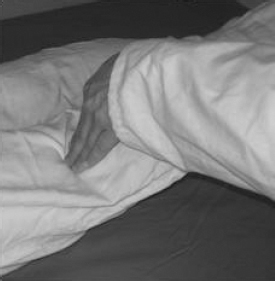
Jifa (击法, Percussing Manipulation)
Percussion involves striking or thumping the body surface rhythmically with the back of the fist, the heel of the hand, the hypothenar eminence (ulnar palm), or the fingertip driven by the wrist joint.
Fist Percussing Manipulation: Make a hollow fist, straighten the wrist, and hit the client’s body surface with the dorsum of the fist evenly.
Palm Percussing Manipulation: Relax the fingers naturally, straighten the wrist, and percuss the client’s body surface with the palm base.
Lateral-palm Percussing Manipulation or Hypothenar Percussing Manipulation: Stretch the fingers naturally, bend the wrist slightly backward, and beat the client’s body surface with the minor thenar of one palm or both.
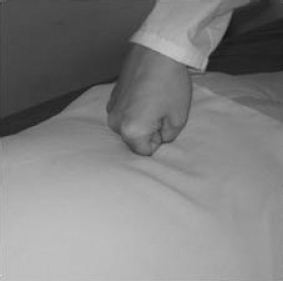
Fingertip Percussing Manipulation: Beat the client’s body surface with fingertips like rain beating the ground.
Stick Percussing Manipulation: Beat the client’s body surface with a stick made up of mulberry twigs. When percussing manipulation is operated, the beating should be quick, with a short-term touch to the client’s body; percussing movement on the body surface is made vertically, at an even and rhythmic speed. Any dragging and whipping movement should be avoided.
Fist percussing manipulation may be applied to the client’s back, palm percussing manipulation may be applied to the head vertex, and lumbus, buttocks, and limbs, and fingertip percussing manipulation may be applied to the head, face, chest, and abdomen. These percussing manipulations are used for improving tendons, normalizing meridians, circulating and harmonizing Qi and Blood, etc.
Mofa (抹法, Wiping Manipulation)
Wiping manipulation is performed by attaching the whorl surface of one thumb or palm or both thumbs or palms close to the skin and doing up-and-down or left-and-right rubbing action.
The rubbing should be gentle, stable, and slow.
It may be applied to the client’s head, face, and nape for awakening the consciousness, calming the mind, refreshing the brain, or improving vision (see Fig. 18.9).
Qiafa (掐法, Nipping Manipulation)
Nipping manipulation is performed by heavily stabbing and pressing the client’s point with the finger nail rhythmically. During the operating, the force should be gradually increased until it gets into the inner part, but without any injury to the skin. Gentle kneading of the local area is often applied after the nipping manipulation to relieve the sensation of irritation. This manipulation is often used in combination with kneading manipulation — called nipping–kneading manipulation.
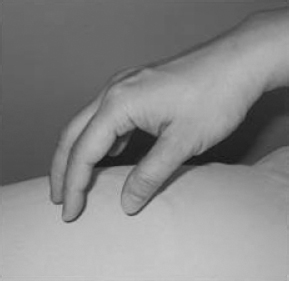
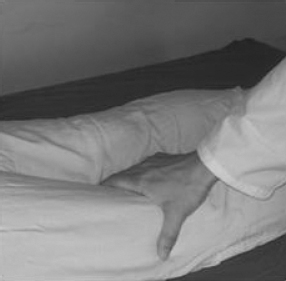
It may be applied to the client’s face and four limbs for refreshing the brain, awakening the consciousness, or relieving spasms .
Doufa (抖法, Shaking Manipulation)
Hold the distal end (i.e. hand or foot) of the client’s upper or lower limb with one or both hands and make constant, up-and-down trembling movements through small amplitude. To be effective, the range of movement should be small while the frequency should be great.
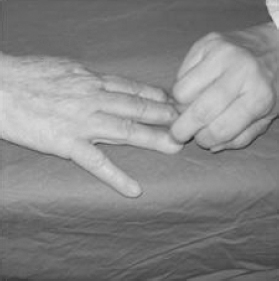
Doufa may be used on the limbs, especially the upper limbs. In the clinic, this method is often combined with palm twisting manipulation to end the treatment. It has the same therapeutic effect as palm twisting manipulation.
It may be applied to the limbs, especially the upper limbs, as an ending manipulation for relaxing the body or distributing energy.
Yaofa (摇法, Rotating Manipulation)
Rotating manipulation is performed by holding the client’s body part and having one joint rotating.
Ankle-rotating manipulation is one of the most common manipulations. We hold the client’s foot end with the hand to have the ankle joint make a rotating movement. During the operating, the manipulation should be moderate, stable, and gentle. The rotating amplitude and frequency should be acceptable to the client.
This technique can be used on the client’s joints, especially on the lower limbs. In the clinic, it is often used to activate and facilitate the body joints. It has a good therapeutic effect for body stiffness and limitation of body movement.
It may be applied to the joints of the limbs, nape, and lumbus for freeing joints or improving their functions.
The Tuina Procedure
Nanjing Tuina Massage 24 is one of the most commonly used routines. It is widely used not only in China but also in North America. Currently, it is the most popular method in Canada. The versatility of the protocol allows it to be used to treat almost all disorders encountered in the clinic.
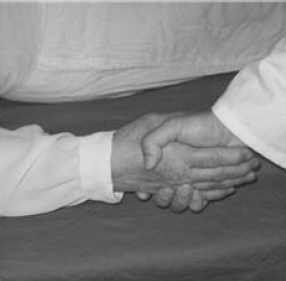
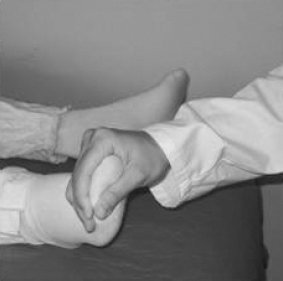
Brief Introduction to Nanjing Tuina Massage 24
Nanjing Tuina Massage 24 consists of 24 steps. For an outline of the major content.
General Treatment Procedure of Nanjing Tuina Massage 24
To begin, the practitioner greets the client and introduces himself or herself. The practitioner should ask whether the client has ever had Tuina. If the client has no experience of Tuina, the practitioner may wish to provide more explanation and some reassurance.
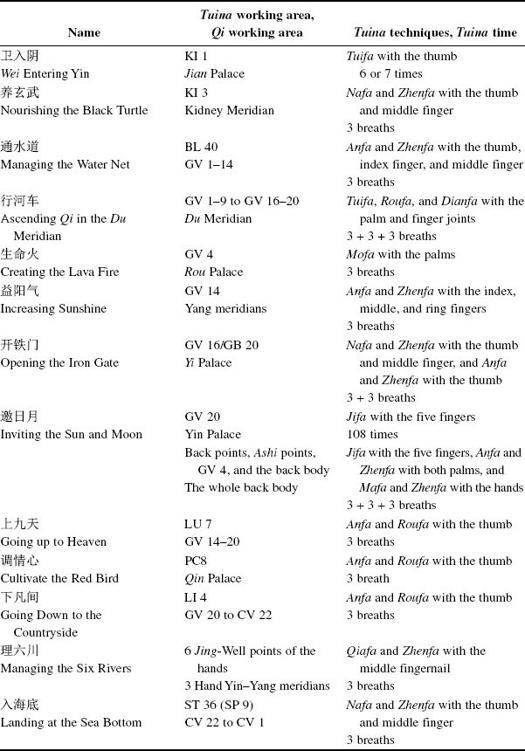
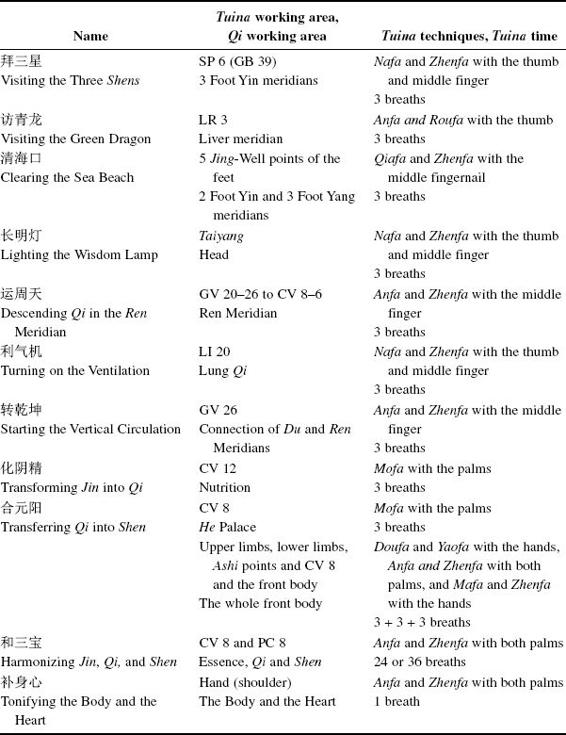
Next, the four diagnoses are performed: observation, listening and smelling, inquiry, and palpation. As with any TCM diagnostic procedure, inquiry should elicit details regarding the location of pain in the body, sensations and locations of Cold or Heat, appetite, sleep, menstruation, bowel movement and urination, and so on. After formulating the diagnosis and treatment principles (the practitioner may choose to share some or all of this information), the practitioner instructs the client to change his or her clothes, then leaves the treatment room. When the client has finished changing clothes, the practitioner can knock on the door for permission to re-enter the treatment room. Heating lamps and soothing music are turned on and the practitioner washes his or her hands before starting Nanjing Tuina Massage 24. Wearing a white lab coat when treating clients allows the practitioner to stay clean, neat, and professional.
When treating a client, the practitioner must pay careful attention to the client’s feelings. It is not enough to assume that the client feels a particular way or is experiencing a certain emotion. A good practitioner will establish and maintain a respectful open dialogue to monitor the client’s state of mind throughout the treatment. When speaking to a client, the practitioner should use a soft and kind voice. During treatment, the practitioner should remain humble, considerate, and kind to the client. It is important to remember that the practitioner uses not only the hands but also the head and heart when delivering a treatment. It is strongly recommended to keep a reassuring smile while treating the client.
Massage is first performed on the back, then on the front. The total treatment time is about 30 min. When the treatment is completed, the practitioner asks the client to change back into his or her clothes, and reminds the client to bring all of his or her belongings from the treatment room.
Detailed Manipulation and Function
The practitioner first asks the client to lie with the face down on the treatment bed and place both hands naturally.
Step 1: Use one hand to hold the patient’s foot, and push into KI 1 Yongquan backward with the thumb of the opposite hand with Tuifa six or seven times. This step is very important, because KI 1 Yongquan very powerfully leads the client Wei (defensive) Qi entering the internal body, and calms the client’s mind and releases waste energy. At the same time, some earth energy may enter the client’s body though KI 1 Yongquan.
Step 2: Use the middle finger and the thumb simultaneously to press KI 3 Taixi and BL 60 Kunlun, and shake them with Zhenfa in three breaths. This action will tonify the Kidney system and detoxify the Bladder system.
Step 3: With one hand hold the client’s ankle, and use the index, middle, and ring fingers of the other hand to press into and vibrate BL 40 Weizhong with Anfa and Zhenfa in three breaths. Since this step facilitates the movement of Qi from GV 1 Changqiang to GV 14 Dazhui, it is effective for the leg and the low back discomfort.
Step 4: Push the heel of the hand along the client’s back from GV 1 Changqiang to GV 9 Zhiyang, GV 16 Fengfu, and then GV 20 Baihui with Tuifa in three breaths. Then use Roufa to knead the back from GV 1 Changqiang to GV 20 in three breaths, and finally use finger joints to push EX-B 2 Huatoujiaji of both sides of the spinal cord upward with Dianfa in three breaths. This is the best way to stimulate the Du Meridian and normalize the body system functions.
Step 5: Rub the area of GV 4 Mingmen on the client’s back in a circular pattern with the palms with Mofa in three breaths to activate the client’s Kidney Yang or Life Fire. This special maneuver activates the Life Gate (Mingmen) Fire to warm the body.
Step 6: Use the index, middle, and ring fingers of the left hand to press and vibrate the GV 14 Dazhui area with Anfa and Zhenfa in three breaths, with the right palm resting on the client’s GV 4 Mingmen. Stimulating this area increases Blood and Qi circulation in the upper limbs to improve their function.
Step 7: Move to the client’s head, hold GV 20 Baihui with the left hand and use the right thumb and the middle finger to press and vibrate GB 20 Fengchi on both sides of GV 16 Fengfu with Nafa and Zhenfa in three breaths, then use the thumb to press GV 16 Fengfu directly with Anfa and Zhenfa in three breaths. This maneuver provides indirect stimulation to the gall bladder system and direct stimulation to GV 16 Fengfu to facilitate the entry of Qi into the skull to nourish the brain and improve its function.
Step 8: Use the fingers and thumb of the right hand to tap the client’s GV 20 Baihui and the surrounding area with Jifa for 108 times. This invigorating technique allows the body to more readily receive and integrate Qi from GV 20 Baihui, and also promotes Blood and Qi circulation in the head.
The above eight steps are carried out on the client’s back. When these steps are completed, tap the client’s back points with five fingers with Jifa in three breaths, then place both palms on any Ashi points with Anfa and Zhenfa which the client has mentioned in three breaths, and then on GV 4 mingmen with Anfa and Zhenfa in three breaths. Finally, use Mafa and Zhenfa on the whole back of the client’s body with the hands. It is very important to achieve immediate local effect and subsequent general effect. Then the client is instructed to change his or her position to face upward.
Step 9: Holding the client’s arm with one hand, press LU 7 Lieque with the thumb of the opposite hand with Anfa and Roufa in three breaths. Qi is thereby encouraged to move from GV 14 Dazhui to GV 20 Baihui and any stagnation in the back of the head is eliminated. This is effective for most of the nape, cervical vertebra, and head back problems.
Step 10: While holding the client’s palm in one hand, use the thumb of the other hand to press PC 8 Laogong with Anfa and Roufa in three breaths. This step is very effective in helping the client’s pericardium to release waste fluid, in reducing pressure on the Heart, and in normalizing Heart function. Not only does the physical heart benefit from this maneuver, but the Shen is likewise supported, providing wonderful relief for the client with depression.
Step 11: Still holding the client’s hand, move the thumb of the other hand to LI 4 Hegu and press it with Anfa and Roufa in three breaths. Qi movement from GV 20 Baihui to CV 22 Tiantu is promoted, and face and throat problems are relieved.
Step 12: Stimulate the six hand Jing-Well points by pressing each acupoint respectively with the nail of the middle finger with Qiafa and Zhenfa in three breaths. This procedure is especially effective for releasing the waste energy from the client’s body above the diaphragm. It is useful for most of the excessive diseases in the head, chest, and upper back.
Step 13: Moving to the client’s lower body, grasp the leg below the knee with the thumb and middle finger at ST 36 Zusanli and SP 9 Yinlingquan. Press and vibrate these two points simultaneously with Nafa and Zhenfa in three breaths. This action facilitates Qi movement from CV 22 Tiantu to CV 1 Huiyin and promotes the descent and digestion of food in the digestive system, thereby optimizing nutrition production and distribution. ST 36 Zusanli is one of the two best points for regulating the internal organs, improving the body’s defensive system, and achieving longevity.
Step 14: Use the thumb and the middle finger to grasp above the ankle at SP 6 Sanyinjiao and GB 39 Xuanzhong (also known as Juegu). Press and vibrate the two acupoints simultaneously with Nafa and Zhenfa in three breaths. SP 6 Sanyinjiao is the best point for normalizing menstruation for female clients and benefits the liver, spleen, and kidney systems together for all clients. It is a representative point for improving the function of the client’s body below the diaphragm.
Step 15: Cupping one hand underneath the client’s heel to stabilize the foot, press LR 3 Taichong with Anfa and Roufa in three breaths with the thumb of the opposite hand. Since this is the most powerful point for circulating Liver-Qi and eliminating stagnation from the body, this step is especially effective for reducing stress and regulating the emotions.
Step 16: Press each of the five foot Jing-Well points in turn with Qiafa and Zhenfa in three breaths with the nail of the middle finger actively to promote the release of waste energy from the client’s body below the diaphragm. This is useful for most of the excessive diseases in the abdomen and low back.
Step 17: Place the left hand on top of the client’s head and use the thumb and the middle finger of the right hand to press and vibrate both EX-HN 5 Taiyang points with Nafa and Zhenfa in three breaths. Many disorders of the head can be treated with this maneuver.
Step 18: With the fingers and the thumb of the right hand, press and vibrate the anterior midline of the client from GV 20 Baihui to GV 26 Shuigou, CV 8 Shenque, then CV 6 Qihai with Anfa and Zhenfa in three breaths to facilitate the descent of Qi along the anterior aspect of the body.
Step 19: Steady the client’s head by placing the left hand on the vertex. Place the thumb and the middle finger of the right hand on either side of the nose at LI 20 Yingxiang. Press and vibrate the points with Anfa and Zhenfa in three breaths to regulate respiration.
Step 20: Still using the left hand to hold the client’s head, press and vibrate GV 26 Shuigou (also known as Renzhong) with the middle finger of the opposite hand with Anfa and Zhenfa in three breaths. Stimulating this point re-establishes the connection between the Du and Ren Meridians, and facilitates the back-to-front vertical circulation of Qi.
Step 21: Place both palms on CV 12 Zhongwan and perform Mofa in three breaths to benefit the client’s digestive system and nutrition production.
Step 22: Move both palms down slightly to knead the client’s umbilical area at CV 8 Shenque with Mofa in three breaths to activate the body’s Qi entry point and improve its function.
The above 14 steps are applied to the front of the client’s body. Then we may shake both upper limbs with the hands with Doufa in three breaths, respectively, and rotate both lower limbs with the hands with Yaofa in three breaths. At this juncture, place both palms on any Ashi points the client may have mentioned, with Anfa in three breaths, then move them to CV 8 and remain there with Anfa and Zhenfa in three breaths. Finally, we use Mofa and Zhenfa on the whole front of the client with the hands. This is very important for achieving immediate local effect and subsequent general effect. Then the client is advised that the treatment is almost finished.
Step 23: Place the client’s palms over the umbilicus at CV 8 Shenque. Then place both palms directly over the client’s hands and apply Anfa and Zhenfa 24 or 36 times to induce all the Qi to enter his or her body’s “energy bank.”
Step 24: Keep the right palm on the client’s hands and gently touch the client’s right shoulder with the left hand with Anfa and Zhenfa in one breath, and tell him or her that the treatment is finished.
Finally, the heating lamp is turned off and the client is given privacy to change back into his or her clothes.
Contraindications for Nanjing Tuina Massage 24
For pregnant women, do not stimulate SP 6 Sanyinjiao, LI 4 Hegu, BL 60 Kunlun or BL 67 Zhiyin, or GB 21 Jianjing. For women who are not pregnant, avoid CV 5 Shimen. The points or areas forbidden for all clients are swollen body parts and areas of skin injury.
Tuina Self-Massage
It is possible and recommended to perform simple Tuina manipulations such as pushing, grasping, pressing, rubbing, kneading, and thumping on certain acupoints and specific areas to treat diseases or release discomfort from one’s own body. This is called Tuina self-massage, and it is a very important part of TCM because practitioners can treat their clients well only when they themselves are in optimal health.
Tuina self-massage can be performed in the sitting, standing, or reclining position. To get the most out of this therapy it should be carried out with a calm mind, natural respiration, and a relaxed body. The applied force should be gentle, so that the body is not hurt. As with Tuina performed on others, a different amount of force is used for each specific region. Generally speaking, the anterior aspect of the body tolerates less force than the posterior aspect and the body trunk tolerates less force than the limbs.
When Tuina is performed on oneself, the hands and the body are kept dry and clean. Once the body areas warm up, the massage should stop. Otherwise, the skin may be damaged. Ideally, this Tuina self-massage should be performed twice daily, in the morning and the evening. Each massage may take 20–30 min.
Some practitioners may become easily tired when implementing this program. Some may also experience pain or soreness in their hands. This is all normal and will gradually disappear with continued practice. With regular long-term self-massage, any feeling of discomfort will be replaced by a feeling of warmth and ease.
Tuina Self-Massage on the Back and Lumbar Region
Press intervertebrae horizontally along the Du Meridian from GV 1 Changqian to GV 14 Dazhui with the fingers with Anfa three times. Then press EX-B 2 the Huatou Jiaji acupoints from the low back to the upper back with the knuckles with Anfa three times. Next, tap the Bladder Meridian with the hollow fists three times. Use the fingers and palms to knead GV 4 Mingmen, BL 23 Shenshu and BL 52 Zhishi and the surrounding areas with Mofa until they become warm. Finally, place the palms on GV 4 Mingmen for 1 min.
Tuina Self-Massage on the Head and Face
Press GV 26 Shuigou with the middle finger with Anfa and Zhenfa in three breaths. Next, with the thumb and the middle finger on either side of the nose, press LI 20 Yingxiang with Nafa and Zhenfa in three breaths. Press both EX-HN 5 Taiyang acupoints with the middle fingers with Anfa and Zhenfa in three breaths, and then tap the head with all of the fingers with Jifa for 108 times. Finally, rub the entire face, ears, nose, and eyes with the fingers and the palms with Roufa till the face becomes warm.
Tuina Self-Massage on the Upper and Lower Limbs
Press PC 8 Laogong with the thumb with Anfa and Roufa in three breaths; then press ST 36 Zusanli bilaterally with both thumbs with Anfa and Roufa in three breaths. Next, press KI 1 Yongquan acupoints with the thumbs with Anfa and Roufa in three breaths. Finally, knead the feet with the palms until both the palms and the feet are warm.
Tuina Self-Massage on the Chest and Abdomen
Begin by pressing CV 22 Tiantu and CV 17 Tanzhong (also known as Danzhong) with the thumbs with Anfa and Zhenfa in three breaths. Then knead the following points with the palms with Anfa and Roufa in three breaths, respectively: CV 12 Zhongwan, CV 8 Shenque, CV 6 Qihai, and CV 4 Guanyuan. Finally, tap the chest and abdomen with the hollow fists three times and place both palms over CV 8 Shenque for 1 min.
The above Tuina self-massage is a very effective technique, in general, for improving one’s health. Specifically, diligent practice can eliminate disease, reduce stress and body discomfort, and increase energy levels while calming the Mind and relaxing the body. Adhering to a twice-daily schedule will allow the body and Mind to be gradually harmonized.

